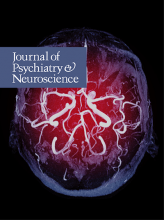High-risk studies have reported an increased prevalence of attention-deficit/hyperactivity disorder (ADHD) in children born to parents with bipolar disorder (BD).1 There is also evidence that children with ADHD have a higher risk of BD being diagnosed later in life.2 Given that ADHD is often a lifelong condition, it is expected and reported3 that ADHD and BD co-occur often.
A 25-year-old man first came to psychiatric attention when he was 18 years old after experiencing a manic episode with psychotic features in the context of cannabis abuse. He did not have any first-degree relatives with psychiatric disorders. Several years later, he presented with ADHD symptoms, mainly concentration and attention difficulties and impulsive behaviours. The diagnosis of ADHD was retained after a complete screening. The rest of the psychiatric evaluation did not identify any other symptoms. Atomoxetine was initiated and titrated to 80 mg daily. A dramatic improvement of ADHD symptoms was observed and was sustained for a few months without major adverse effects. Thereafter, he presented with disorganized behaviour, euphoria and religious exaltation. Atomoxetine was discontinued, and after few months he agreed to take long-acting aripiprazole. The manic symptoms remitted completely, and the patient resumed all functioning except for his work, owing to attention and concentration problems.
After a few months, a small dose (18 mg/d) of atomoxetine was restarted. The patient reported that 3 days later he began to feel euphoric, excited and invincible; his ideas began to race; and he was engaged in physical training all night long, not feeling the need to sleep. Consequently, atomoxetine was stopped and a small dose of benzodiazepines was added. A remission of the manic symptoms quickly ensued. Given the persistent complaints of attention difficulties, clonidine was added thereafter and titrated progressively from 0.05 mg/d in the evening to 0.10 mg twice daily. This treatment was well tolerated and the patient’s condition improved considerably, allowing him to reintegrate his work.
A few systematic studies have investigated the efficacy and tolerability of medication use in the treatment of ADHD comorbid with BD. Treatment for ADHD often involves medication. Some literature suggests that psycho-stimulants, the first-line treatment, can induce manic and psychotic symptoms.4 However, other studies have reported contradictory results. Notably, Galanter and colleagues5 showed that children with ADHD and comorbid manic symptoms responded well to psychostimulants without increased risk of manic episodes. Moreover, BD in youth can be treated with atypical antipsychotics,6,7 which can offer protection against manic or hypomanic symptoms. Psychostimulants given with antipsychotics could be a good therapeutic approach.
Atomoxetine, a specific blocker of the norepinephrine transporter, is widely used to treat ADHD, but has also been associated with mania and hypomania or mood dysregulation or irritability in 33% of patients with ADHD,8 but some research has indicated that atomoxetine could be a safe treatment for children with ADHD9 and comorbid BD. α-2 agonists, such as clonidine and guanfacine, are indicated for the treatment of ADHD symptoms, particularly in comorbid cases.10 Clonidine has also been reported to be effective in the treatment of manic episodes.11–13
In summary, data on the treatment of ADHD in patients with comorbid BD are sparse. Clinicians should first make sure that the bipolar symptoms are under control, then propose medications that could improve attention problems. Medication with strong evidence for treating ADHD symptoms, notably psychostimulants and atomoxetine, could be tried, while monitoring for the emergence of symptoms, once the mood symptoms are stabilized with a medication. Clonidine (and possibly guanfacine) may also be offered, as they have been shown to be effective in controlling manic symptoms and improving attention.
Footnotes
The information in this column is not intended as a definitive treatment strategy but as a suggested approach for clinicians treating patients with similar histories. Individual cases may vary and should be evaluated carefully before treatment is provided. The patient described in this column is a composite with characteristics of several real patients.
Competing interests: R. Joober sits on the advisory boards and speakers’ bureaus of Pfizer, Janssen Ortho, BMS, Sunovion, Otsuka, Lundbeck, Perdue and Myelin; he has received grant funding from them and from AstraZeneca and HLS. He has received honoraria from Janssen Canada, Shire, Lundbeck, Otsuka, Pfizer and Perdue for CME presentations and royalties from Henry Stewart talks. None declared by R. Girard.






